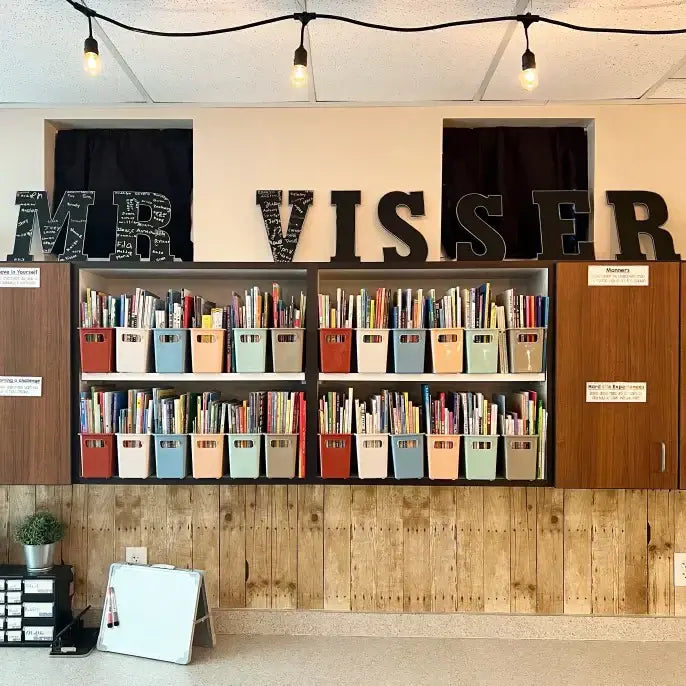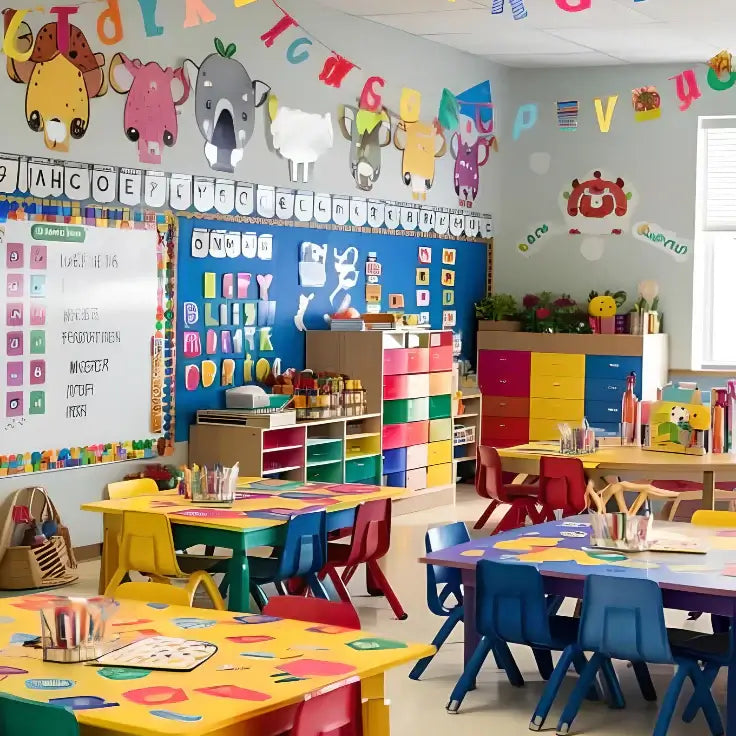Understanding Inquiry-Based Learning Spaces
The Shift from Traditional to Exploratory
Traditional classrooms with rows of desks facing forward are giving way to dynamic spaces that invite questions, experimentation, and collaborative discovery. In these environments, educational rugs serve as foundational elements that:
- Define exploration zones
- Create comfortable investigation spaces
- Support flexible grouping
- Encourage movement and interaction
The Philosophy Behind the Design
Inquiry-based classrooms operate on the principle that learning happens through exploration, questioning, and discovery.
Research from educational design experts shows that physical environments directly impact students' willingness to take intellectual risks and engage in deep learning.
Creating Wonder Zones with Strategic Rug Placement
Discovery Corners
Science Investigation Areas Large, durable rugs create designated spaces where students can:
- Conduct hands-on experiments
- Spread out materials for observation
- Collaborate on group investigations
- Document findings comfortably
Math Manipulation Zones Pattern-rich rugs support mathematical inquiry through:
- Built-in grids for spatial reasoning
- Geometric designs for pattern exploration
- Number sequences for counting activities
- Measurement opportunities using rug boundaries
Question Circle Spaces
Circle-time rugs create democratic spaces where:
- Students share observations and hypotheses
- Questions are valued over answers
- Peer-to-peer learning flourishes
- Teacher facilitation replaces direct instruction
Design Elements That Spark Curiosity
Interactive Patterns and Educational Content
Map and Geography Rugs
- Inspire questions about places and cultures
- Support social studies investigations
- Encourage global thinking
- Provide reference points for research
Nature and Science Themes
- Prompt environmental observations
- Support life science discussions
- Create connections to outdoor learning
- Inspire scientific questioning
Abstract and Open-Ended Designs
- Allow for multiple interpretations
- Support creative thinking
- Encourage pattern recognition
- Avoid prescriptive learning
The Psychology of Inquiry-Friendly Spaces
Color Choices That Encourage Exploration
According to color psychology in education, certain colors promote inquiry:
Earth Tones and Natural Colors—like those used in pastel classroom rugs - can:
- Create calming environments for deep thinking
- Reduce anxiety about making mistakes
- Connect indoor and outdoor learning
- Support sustained investigation
Strategic Bright Accents
- Draw attention to discovery areas
- Energize collaborative spaces
- Mark transition zones
- Celebrate learning achievements
Texture and Sensory Considerations
Multi-textured rugs support inquiry by:
- Providing sensory input for different learners
- Creating comfortable spaces for extended exploration
- Defining areas through tactile boundaries
- Supporting students with sensory needs
Flexible Learning Configurations
Adaptable Rug Arrangements
Mobile Learning Stations Smaller, moveable round rugs allow for:
- Quick reconfiguration for different inquiries
- Student choice in learning locations
- Adaptation to project needs
- Easy storage and rotation
Layering Techniques Combining rugs creates:
- Multi-level learning environments
- Defined spaces within spaces
- Visual interest and variety
- Flexible size adjustments
Supporting Different Types of Inquiry
Scientific Inquiry Spaces
STEM-focused rugs designed for:
- Observation and data collection
- Hypothesis testing
- Materials organization
- Results documentation
Key features include:
- Wipeable surfaces for spills
- Grid patterns for graphing
- Durable materials for equipment
- Neutral backgrounds for clear observation
Literary Inquiry Zones
Reading rugs and writing exploration areas featuring:
- Comfortable surfaces for extended reading
- Inspiring designs for creative writing
- Quiet zones for reflection
- Collaborative spaces for book discussions
Mathematical Inquiry Areas
Rugs that transform into:
- Living number lines
- Geometric exploration spaces
- Pattern investigation zones
- Measurement laboratories
Technology Integration in Rug Spaces
Blending Digital and Physical
Modern inquiry-based classrooms seamlessly integrate technology. Consider:
- Rugs with QR codes linking to resources
- Designated device charging stations
- Screen-free investigation zones
- Augmented reality anchor points
Cultural Responsiveness in Design
Inclusive Inquiry Environments
According to culturally responsive teaching practices, inquiry spaces should:
- Reflect diverse perspectives
- Include multicultural patterns and designs
- Avoid cultural appropriation
- Celebrate various ways of knowing
Assessment-Friendly Design
Making Learning Visible
Inquiry-based rug spaces support assessment through:
- Documentation stations for capturing learning
- Presentation areas for sharing discoveries
- Reflection zones for self-assessment
- Gallery spaces for displaying work
Teacher Facilitation in Designed Spaces
Strategic Positioning
Well-designed rug areas allow teachers to:
- Observe without interrupting
- Join investigations naturally
- Facilitate from within groups
- Move easily between stations
Professional Development Considerations
Research from teacher education sources emphasizes that teachers need support in:
- Understanding space utilization
- Facilitating rather than directing
- Managing multiple investigations
- Assessing inquiry-based learning
Practical Implementation Strategies
Starting Small
Pilot Programs
- Begin with one inquiry zone
- Gather student feedback
- Adjust based on observations
- Expand successful elements
Budget-Conscious Approaches
- Repurpose existing rugs
- Focus on versatile designs
- Invest in quality over quantity
- Seek grants for classroom materials
Maintenance for Active Learning
Durable classroom rugs must withstand:
- Frequent reconfiguration
- Spills from experiments
- Heavy foot traffic
- Daily cleaning needs
Student Voice in Design
Collaborative Planning
Involve students in:
- Selecting rug designs
- Arranging learning spaces
- Creating usage guidelines
- Evaluating effectiveness
Ownership and Investment
When students help design their learning environment:
- Engagement increases dramatically
- Care for materials improves
- Creative use emerges naturally
- Learning becomes more meaningful
Measuring Success in Inquiry Spaces
Observable Indicators
Effective inquiry-based rug areas show:
- High student engagement levels
- Spontaneous investigations
- Collaborative discussions
- Extended time on task
- Creative problem-solving
- Risk-taking in learning
Data Collection Opportunities
Track success through:
- Student questioning frequency
- Project completion rates
- Collaboration quality
- Space utilization patterns
Addressing Common Challenges
Noise Management
Strategic rug placement helps:
- Absorb sound in active areas
- Define quiet investigation zones
- Create natural sound barriers
- Support multiple simultaneous activities
Organization Systems
Well-designed spaces include:
- Clear material storage
- Defined investigation boundaries
- Easy cleanup procedures
- Student-managed systems
Future-Ready Learning Environments
Preparing for Tomorrow
Inquiry-based classrooms with thoughtful rug design prepare students for:
- Collaborative workplaces
- Creative problem-solving
- Self-directed learning
- Adaptable thinking
- Global perspectives
Professional Learning Communities
Sharing Best Practices
According to educational leadership research, successful inquiry-based design spreads through:
- Teacher collaboration
- Classroom visits
- Design documentation
- Student showcase events
Conclusion: Foundations for Lifelong Learning
Inquiry-based classroom design recognizes that learning is an active, social, and creative process.
By thoughtfully selecting and arranging activity rugs, educators create physical foundations that support intellectual exploration.
These carefully designed spaces send a clear message to students: your questions matter, your discoveries are valued, and learning is an adventure worth pursuing.
The transformation from traditional to inquiry-based learning environments doesn't happen overnight, but it begins with recognizing that every design choice—including the rugs we choose—either supports or hinders student exploration.
When we create spaces that invite curiosity, encourage collaboration, and celebrate discovery, we're not just designing classrooms; we're designing futures.




Leave a comment
This site is protected by hCaptcha and the hCaptcha Privacy Policy and Terms of Service apply.